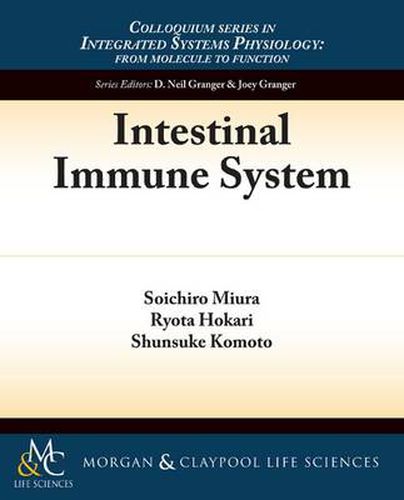Readings Newsletter
Become a Readings Member to make your shopping experience even easier.
Sign in or sign up for free!
You’re not far away from qualifying for FREE standard shipping within Australia
You’ve qualified for FREE standard shipping within Australia
The cart is loading…






In the intestine, a unique immunological system that is different from the systemic immune system exists to provide adaptive immunity in response to luminal bacteria and dietary antigens. There are many lymphoid cell aggregates called gut-associated lymphoid tissue (GALT) including Peyer’s patches (PPs), which function as important induction sites for the mucosal immune response. M-cells are present in the epithelium of PPs, having a specialized structure for uptake of macromolecules such as bacteria. In addition to GALT, there are abundant lymphoid cells in the intestinal lamina propria, where they mainly play a role as immune effector cells. A strong innate immune system that mainly consists of dendritic cells, macrophages, and ??T lymphocytes also exists in the intestinal mucosa to assist the barrier function of intestinal epithelial cells.
The intestinal mucosa thus shows a unique morphological structure with many immune cells being present under physiological conditions. This condition is known as
controlled inflammation.
These abundant immune cells also have characteristic functions: they are
negatively regulated
and have been educated not to overreact unnecessarily to the intestinal luminal milieu. Main players that control inflammation of the intestinal mucosa include regulatory cytokines and regulatory T cells which induce oral tolerance to intestinal bacteria and food antigens, and the secretory IgA system. The maintenance of unique immunological activity in the intestine is also related to an organized, orchestrated lymphocyte migratory mechanism called the
common mucosal immune system.
These negative regulatory mechanisms of the intestinal immune system are disturbed in certain disease conditions, causing the immunocompetent cells to respond to food components and commensal bacteria by becoming activated and to overproduce inflammatory cytokines and chemokines. These disease conditions include food allergies, such as celiac disease, and the inflammatory bowel diseases, such as ulcerative colitis and Crohn’s disease, although their exact etiological mechanisms remain to be revealed.
$9.00 standard shipping within Australia
FREE standard shipping within Australia for orders over $100.00
Express & International shipping calculated at checkout
In the intestine, a unique immunological system that is different from the systemic immune system exists to provide adaptive immunity in response to luminal bacteria and dietary antigens. There are many lymphoid cell aggregates called gut-associated lymphoid tissue (GALT) including Peyer’s patches (PPs), which function as important induction sites for the mucosal immune response. M-cells are present in the epithelium of PPs, having a specialized structure for uptake of macromolecules such as bacteria. In addition to GALT, there are abundant lymphoid cells in the intestinal lamina propria, where they mainly play a role as immune effector cells. A strong innate immune system that mainly consists of dendritic cells, macrophages, and ??T lymphocytes also exists in the intestinal mucosa to assist the barrier function of intestinal epithelial cells.
The intestinal mucosa thus shows a unique morphological structure with many immune cells being present under physiological conditions. This condition is known as
controlled inflammation.
These abundant immune cells also have characteristic functions: they are
negatively regulated
and have been educated not to overreact unnecessarily to the intestinal luminal milieu. Main players that control inflammation of the intestinal mucosa include regulatory cytokines and regulatory T cells which induce oral tolerance to intestinal bacteria and food antigens, and the secretory IgA system. The maintenance of unique immunological activity in the intestine is also related to an organized, orchestrated lymphocyte migratory mechanism called the
common mucosal immune system.
These negative regulatory mechanisms of the intestinal immune system are disturbed in certain disease conditions, causing the immunocompetent cells to respond to food components and commensal bacteria by becoming activated and to overproduce inflammatory cytokines and chemokines. These disease conditions include food allergies, such as celiac disease, and the inflammatory bowel diseases, such as ulcerative colitis and Crohn’s disease, although their exact etiological mechanisms remain to be revealed.